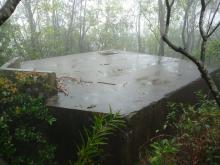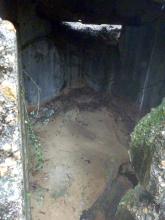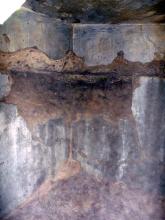15 May 2009 Update: Originally this was listed as a pillbox. Now we know it was an Artillery Observation Post (AOP), so I've updated the title.
There's a picture of this pill box on Google Earth. In that picture you can clearly see Mt Parker in the background. But today the box is completely surrounded by undergrowth and small trees.
The design is different to other PBs I've seen, in that it really does look like a box, a concrete cube. And it's not as big as, say, the PBs at Jardine's Lookout. I wonder if it's an earlier design.
It has one wide, low, loophole which points to the North, maybe for a machine gun. The other walls have small rectangular loopholes. These openings are lined with pebbles. There appear to be no metal covers protecting the loopholes.
Outside above the main loophole is a kind of concrete 'shield', (which I also haven't seen before). The shield is studded with tennis-ball sized stones as camoflage.
The box has suffered major structural damage. It's cracked right through and the cracks run all around the structure. It looks like the cracking was caused by explosions inside, as the interior walls have blast damage but there's no corresponding damage outside. (An attempt at demolition?)
As I mentioned on the Japanese tunnels topic, part of the concrete floor is missing inside. The earth has been dug out and there is a small tunnel leading off to the South. Probably goes 4 to 5 metres. It's crawling room only so I don't know if it stops there or goes on. I didn't crawl in!



Comments
Maybe an Observation Post?
HW, From your description of the 'shield' above the main opening, and the tennis-ball sized camouflage, I wonder if this could have been one of the Observation Posts (OPs) used by the Royal Artillery.
Does it look similar to these photos of other OPs at High West, and Jardine's lookout?
Is the position of the marker on the map above fairly accurate? It looks like it's on top of a hill, which would give a good view down to the sea.
Finally, please could you let us have a link to the photo you mentioned, as I couldn't find it in Google Earth.
Thanks for writing in,
MrB
Probably an OP
MrB - just looked at your photos above. Yes, it does bear a striking similarity, especially the shield and the camoflage stone work.
I tried to position the marker as accurately as I could on the map; it is indeed on the crest of a knoll. An OP looking North makes sense, as I did think it was rather an exposed position for a pill box. As I say, it's surrounded by trees now, but at the time it probably had a good view of the harbour and Kowloon.
When I log into google earth, and then zoom in to that location, the picture icon pops up (captioned as something like 'World War II" from memory). But it only pops up if I zoom in a bit. If I am too 'high up' the icon does not appear. Hope that helps.
HillWalker
PB or OP at Braemer Hill
Dear Mr B,
You have to zoom in pretty close to it's proximity before the photo marker appears. Please try this link instead.
http://www.panoramio.com/photo/9301048
Best Regards,
Thomas
New OP
Gents, thanks for the help on viewing that photo. It does look very much like the other OP's we've seen.
One to add to the list of places to visit.
A visit to Braemar Hill AOP
We paid this AOP a visit a couple of weeks back. If you're using the Countryside Series map for HK Island, you should see a pavilion at approximate coordinates 120-667. It's at the junction of three paths. If you're standing at the junction facing west, the pavilion is on your left, and there's a small track leading up the slope to your right. Take the track to your right, and keep going up until you reach the very top of the hill.
Here's the first view of the AOP:
You can see two small openings have been cut through the concrete. These weren't part of the original design. We're not sure if they were made by the Japanese, or by squatters living there after the war. Over to the left you can see the original doorway.
Walking around to the front, here's the cover over the single observation window. It has the characteristic concrete blobs seen on all the AOPs.
Here's the view across the roof, to show its shape. In the far corner is the ventilation opening. Usually there's a small ventilation shaft sticking up from the opening. It looked as if this one had been broken off.
Looking in through the door, you can see the window in the front, and - TAKE NOTE - a big hole in the floor, just inside and to the right.
Here's the view in the opposite direction:
To give you an idea of why you wouldn't want to fall down the hole, here's the view up from inside it!
As Hillwalker notes, there's a tunnel leading off from the bottom of the hole. (More about the tunnel here.)
Here's what the opening for the observation window looks like. It's almost completely blocked with mud and plant debris now.
Here's a close-up. Did these AOP's have any sort of sliding shutters across the window originally?
And here's a better view of the corner, showing pock marks in the concrete suggesting an explosion. Also note the large crack, and the fact that the top half has shifted slightly from the bottom half. (Looking at the other photos you can see that cracks run right around the building.)
Why the big cracks in the concrete?
As Hillwalker says, it doesn't look as though the AOP was hit by a shell from the outside.
Was it under attack by infantry at any time? Though even if it was, would anything they could throw in to the AOP cause that type of cracking?
We thought the cracks were likely connected with the tunneling that had gone on. Possibly it was caused by subsidence as the earth has settled.
But if you look back at the picture from inside the hole, you can see there is a thick, solid, concrete floor. More likely we guess it was caused by someone getting fed up trying to cut a hole in the concrete floor with manual tools, and deciding to use explosives to do the job. That explosion could also explain the pock-marks in the concrete.
We also wondered about the front window being almost completely blocked up. One suggestion was that spoil from the tunnel would just have been thrown out the window, and build up in front of the AOP. Thinking about it since, I believe the roof would have originally been covered with earth as camouflage. Some of the earth may be from the tunnel, but other likely washed down off the roof over the years.
All other theories gratefully received!
And I was having a bad day with the camera, so this isn't a very clear video, but it gives another view of the layout:
Visit last week, still in excellent condition
Visited last week, still in great condition
re: Visit last week
Thanks for the update, and the photo. (I added the photo to your comment - here's a 'how to', in case you'd like to add others in future: https://gwulo.com/node/1929)